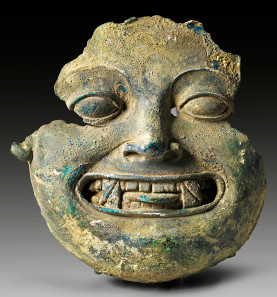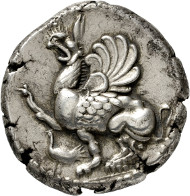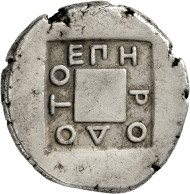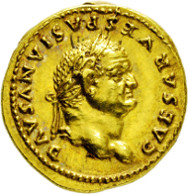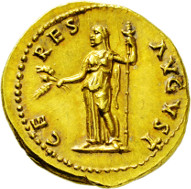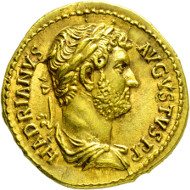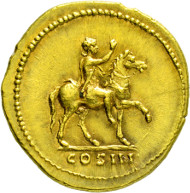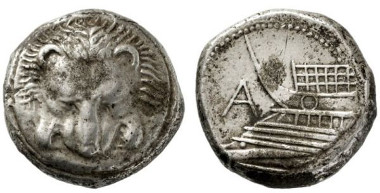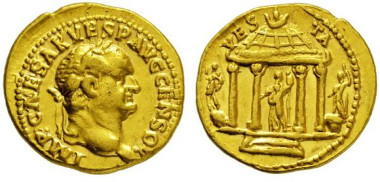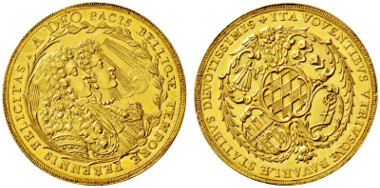20-09-2015 – 25-09-2015
Auction 311-315
Hirsch offers JGJ collection of ancient coins
Auction 311: Precolumbian Art
Starting off the week of auctions by Gerhard Hirsch Nachfolger is the Precolumbian Art. Two notable collections will be up for sale, beginning with the collections of Mexican artwork by A. and B. Schirmer.
1: Western Mexico. Colima. Ca. 200 B.C. – 300 A.D. Standing warrior. H. 46,1 cm.
Among the exquisite objects in this collection is the figure of a warrior, standing with club and helmet, which is valued at EUR 4,500.-.
The collection of Ferdinand Anton, renowned archeologist and ethnologist, will follow, with a female figure painted with geometric designs, originating from Mexico, estimated at EUR 1.000,-.
Auction 312: Antique Objects
Auction 312 will begin with the objects of glass and stone, among them a very attractive torso of a statue of Venus, estimated at EUR15,000.-.
788: Gorgoneion. Bronze. Greek, 5. Jh. Century B.C. H. 15,7 cm.
The title piece, a depiction of a Gorgon made of bronze, is estimated at EUR 7,500.-, which will be followed by weapons, scales and weights, locks and keys, crosses and antique jewelry, cameos, intaglio, stamps and seals. Concluding the auction will be a collection of Egyptica.
Auction 313: Collection J.G.J.
The Collection J.G.J. includes exceptional coins from the Greek and Roman periods. Some of the coins originate from well-known pre-war collections or are published in the standard catalogues.
2014: Thrace. Abdera. Herodotos. Tetradrachm. 473-448 B.C.
The Greek coins will go under the hammer first, with a brilliant uncirculated Tetradrachm (473-448 B.C.), valued at EUR 15,000.- being the title piece of Auction 312. The auction continues with the Roman coinage and a Denarius of Julius Cesar from 44 B.C., the year of his death (EUR 6.000,-).
2063: Roman Empire. Vespasianus. 69-79 A.D. Aureus.
A series of coins from the time of the Roman Empire go under the hammer next, among them many Aurei in perfect condition. Exemplary for these is a brilliant uncirculated Aureus from Vespasian (69-79 A.D.), valued at EUR 25.000,- and depicted in Calico 593.
2071: Roman Empire. Hadrianus. 117-138 A.D. Aureus.
One of the other title pieces of the auction is an Aureus from Hadrian (117-138 A.D.) struck to commemorate the festive entrance of the Emperor into Rome in 125 and is valued at EUR 17.500,-. The last items up for auction are 7 coins from the Byzantine Empire, among them an Au-Histamenon of Theodora (1055-1056 A.D.) with a valuation of EUR 2,000.-.
Auction 314: Ancient Coins
The auction begins with the Celtic coinage, among them a rainbow cup of the type VI A from southern Germany, brilliant uncirculated condition, estimated at EUR 4.500,-.
2266: Sicily. Messana. Tetradrachm. 494/493 B.C.
The Greek coins will be auctioned next, beginning with a Tetradrachm from Messana depicting the scalp of a lion, valued at EUR 10.000,-.
2603: Egypt. Ptolemaios IV. Philopatoros. 221-204 B.C. Gold-Octodrachm.
Carrying an estimate of EUR 13,000,- is a golden Octodrachm from Egypt, struck under the reign of Ptolemeus IV Philapatoros and is from the Conanicus Collection.
The Roman coins begin with the coinage of the Roman Republic and civil war period, with a rare Dinar from the year 44 B.C. of Marcus Antonius valued at EUR 2,200.-. The auction then continues with the coins of the Roman Empire.
2732: Roman Empire. Vespasianus. 69-79 A.D. Aureus.
An Aureus from Vespianus (69-79 A.D.) with the temple of Vesta on the reverse is estimated at EUR 15,000-. From the reign of Maximinus II Daia (309-311 A.D.) a very rare, brilliant uncirculated Aureus is valued at EUR 9,000.-.
3115: Byzantine. Irene. 797-802 A.D. Solidus.
The Byzantine coins follow, with a rare Solidus of Irene (797-802 A.D.), the first woman to reign without a consort, valued at EUR 7,500.-. Coinage from the Nicean Empire, migratory period, Byzantine lead seals, lots of multiple coins, and valuable literature concerning the ancient coins round out this auction.
Auction 315: Modern Coins and Medals
Starting the auction of Modern coins and Medals are the coins of the Middle Ages, with a Denar of Konrad II (1026-1027) estimated at EUR 3,500.-. The coinage of the German and Habsburg counties is the next to be up for auction.
3588: Bavaria. Maximilian II. Emanuel. 1679-1726. Munich. 5 Ducat. Present of the Bavarian estates for the wedding of the prince-elector in 1685.
A 5 Ducat struck under the reign of Maximilian II Emanuel as a present of the Bavarian estates for the wedding of the prince-elector in 1685, in brilliant uncirculated condition, is valued at EUR 12,500.-.
3790: Braunschweig-Lüneburg. Frederick Ulrich. 1613-1634. Goslar. Broad Löser of 6 Reichstaler, 1620.
The Collection H.T. showcasing the coinage of the Markgravate of Brandenburg-Franconia continues the auction, with a broad Löser of 6 Reichstaler from 1620 struck under Frederick Ulrich valued at EUR 15,000.-
Among the newer German coinage there is a brilliant uncirculated Isar Gold Ducat from 1630, the last of its kind, struck under Ludwig I and valued at EUR 9,000.-.
4257: Bavaria. Ludwig III. 1913-1918, Munich. 3 Mark 1913 (sic !) D.
Following these are the coins of the German Empire, with a 3 Mark 1913 D from Ludwig III being valued at 10,000.-.
Two noteworthy pieces from the World coins are a Ducat struck in 1650 during the reign of Cristina of Sweden, estimated at EUR 15,000.- and a Taler from 1643 struck in Riga is valued at EUR 18,000.-. Concluding the auction are Medals of the medalist Karl Goetz as well as 13 Icons of the Eastern Orthodox Church.
The complete auction catalogues of auction 311-315 you may find on the website of Gerhard Hirsch Nachfolger.





